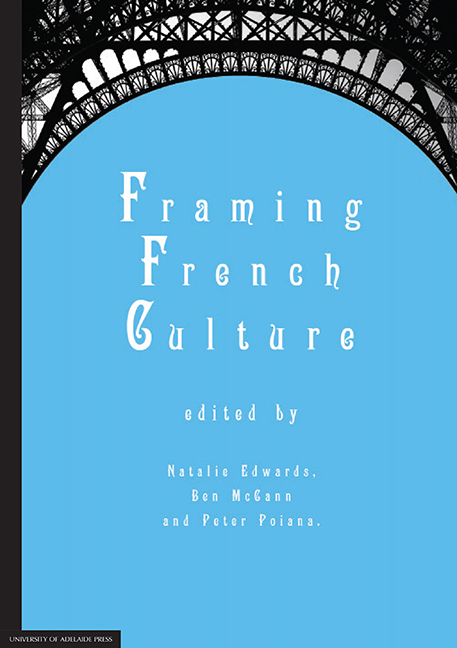1 - The doubling of the frame — Visual art and discourse
from Introduction
Published online by Cambridge University Press: 05 February 2016
Summary
The notion of framing is one that has emerged as a key factor in current investigations into representations of culture. In the disciplinary area of French Studies, framing is understood as collective and individual rules of identity construction that are based upon a combination of modes of visual production, past and present narratives, and discourses of knowledge and power. The present volume will pursue the question of framing in all three areas.
The first sustained discussion of framing, understood in the modern sense, is attributed to anthropologist and linguist Gregory Bateson. In 1954, in ‘A theory of play and fantasy’, Bateson argued that no form of communication can be understood without reference to its metacommunicative frame; monkeys are able to distinguish the same gestures as aggression or as play, depending upon their framing, according to one of his examples. Sociologist Erving Goffman took up the concept in Frame analysis (1974), positing that individuals interpret experiences and situations through a series of frames. These frames are cognitive structures that guide perception; if one saw a person being chased down the street by a police officer, one could surmise that s/he had committed a theft, for example. The notion was soon adopted in the field of Literary Studies, which during the 1970s was busily adopting models from other disciplinary areas as ways of changing the scope and pattern of traditional literary interpretation. The rise of structuralism in particular gave prominence to the idea of ‘narrative’ and to the ‘science’ of narratology, and Gerald Prince notes how this new theoretical application led to the positioning of ‘narrative as a thematic frame’.
Unsurprisingly, perhaps, framing as a theoretical device has since been employed across an array of disciplines to open new modes of interpretation, and between disciplines as a way of crossing disciplinary borders. Studies of the use of frames exist in, for example, Sociolinguistics, Cultural Studies, Psychology and Psychotherapy, Anthropology, Sociology, Museum Studies, Film Studies, Architecture, Cognition Theory, Discourse Theory, Artificial Intelligence, Postcolonial Studies, Intermediality Studies, Communications and Policy Studies. Framing has become commonplace and we readily accept that we interpret the world through the medium of frames. We understand reading, in its broadest sense, as a framing activity and use framing as a way of approaching the heterogeneous quality of texts.
- Type
- Chapter
- Information
- Framing French Culture , pp. 3 - 26Publisher: The University of Adelaide PressPrint publication year: 2015



